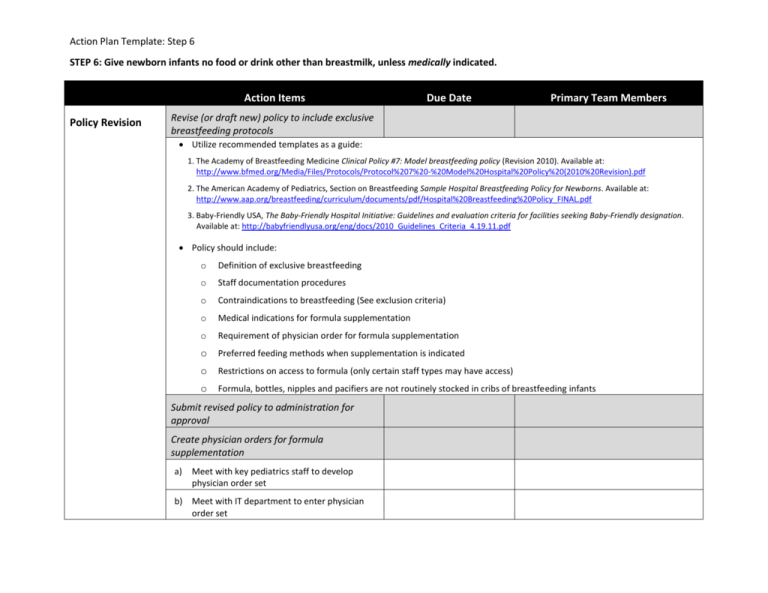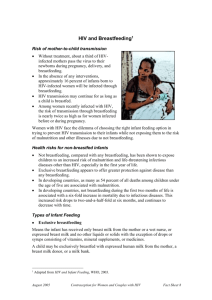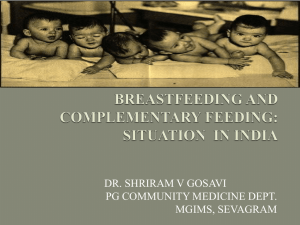Step 6 (Exclusive Breastfeeding) Action Plan
advertisement

Action Plan Template: Step 6 STEP 6: Give newborn infants no food or drink other than breastmilk, unless medically indicated. Action Items Policy Revision Due Date Primary Team Members Revise (or draft new) policy to include exclusive breastfeeding protocols Utilize recommended templates as a guide: 1. The Academy of Breastfeeding Medicine Clinical Policy #7: Model breastfeeding policy (Revision 2010). Available at: http://www.bfmed.org/Media/Files/Protocols/Protocol%207%20-%20Model%20Hospital%20Policy%20(2010%20Revision).pdf 2. The American Academy of Pediatrics, Section on Breastfeeding Sample Hospital Breastfeeding Policy for Newborns. Available at: http://www.aap.org/breastfeeding/curriculum/documents/pdf/Hospital%20Breastfeeding%20Policy_FINAL.pdf 3. Baby-Friendly USA, The Baby-Friendly Hospital Initiative: Guidelines and evaluation criteria for facilities seeking Baby-Friendly designation. Available at: http://babyfriendlyusa.org/eng/docs/2010_Guidelines_Criteria_4.19.11.pdf Policy should include: o Definition of exclusive breastfeeding o Staff documentation procedures o Contraindications to breastfeeding (See exclusion criteria) o Medical indications for formula supplementation o Requirement of physician order for formula supplementation o Preferred feeding methods when supplementation is indicated o Restrictions on access to formula (only certain staff types may have access) o Formula, bottles, nipples and pacifiers are not routinely stocked in cribs of breastfeeding infants Submit revised policy to administration for approval Create physician orders for formula supplementation a) Meet with key pediatrics staff to develop physician order set b) Meet with IT department to enter physician order set Action Plan Template: Step 6 Data Collection Plan Development Update data collection process to capture exclusive breast milk feeding and related variables a) Define data collection variables and exclusion criteria (See Appendix A) b) Develop plan to track exclusive breast milk feeding according to the Joint Commission’s Perinatal Care Core Measure Set (See Appendix) c) Revise nurse charting flowsheet(s) and patient education documentation d) Revise pediatrician charting flowsheet (optional) e) Determine primary person(s) to conduct chart audits and/or run EMR reports f) Patient Education Determine monthly audit schedule Mothers choosing not to breastfeed or to provide formula supplementation should be counseled in order to make an informed feeding decision a) Develop documentation procedure for counseling and informed consent process b) Develop scripting for RNs to be able counsel mothers that request formula supplementation c) Develop or revise patient education material related to the importance of exclusive breastfeeding, the risks of formula feeding, and medical indications for formula feeding Action Plan Template: Step 6 Staff Training Train all staff on the benefits of exclusive breastfeeding, the risks of formula, contraindications to breastfeeding, medical indications for formula supplementation, patient education and counseling protocols, revised policy and procedures, and documentation. a) Develop education plan to train all maternity nursing staff on revised policy, procedures and documentation methods, importance of exclusive breastfeeding, risks of formula feeding, and acceptable medical reasons for formula feeding. (Examples: Staff meeting inservice, lunch & learn, email in-service) b) Implement education plan to train all maternity nursing staff on revised policy, procedures, documentation methods, importance of exclusive breastfeeding, risks of formula feeding, and acceptable medical reasons for formula feeding c) Track participation in training sessions to ensure all staff are trained d) Work with medical and non-clinical staff to ensure all other staff are educated on policy and procedure changes Data Collection Plan Implementation Collect, analyze and report data at regular intervals (recommended: monthly) a) Collect data per previously determined method and schedule (Refer to Data Collection Plan Development) b) Report data summaries to breastfeeding multidisciplinary committee (Work with QI Dept.) c) Identify inconsistencies with policy compliance and documentation d) Examine barriers to implementing policy changes e) Develop strategies to address identified barriers to implementing policy changes Action Plan Template: Step 6 Appendix A: Exclusive breastfeeding data collection Sample data collection variable definitions and exclusion criteria: a. Definitions: 1. Exclusive breast milk feeding - Neonate receives breast milk only, either through breastfeeding or on the consumption of pumped or expressed breast milk. This may include expressed breast milk from a donor. This excludes intake of fortified breast milk. 2. Formula feeding only - Neonate receives formula and/or other liquids including water, sugar water, fortified or specialty formula. 3. Both (Breastfeeding and Formula feeding) - Neonate receives breast milk and formula, but does not consume any other fluids (water, sugar water, etc.) Fortifier is to be treated as “formula” when added to breast milk and specialty formula should be treated like any other type of formula b. Exclusion criteria/Clinical contraindications (Utilize the criteria already in place at your facility to determine if mother/baby dyad is ineligible for breastfeeding/breast milk): 1. Maternal i. HIV+ vii. Illicit drug use ii. Active TB viii. Alcohol abuse iii. HTLV+ ix. Lead ≥ 40mcg/dL iv. HSV breast lesions x. Medications contraindicated with breastfeeding v. Radiation therapy xi. ICU admission vi. Active varicella xii. Demise 2. Infant i. Galactosemia ii. Demise iii. Adoption iv. NICU admission v. DCFS hold vi. Transferred out Action Plan Template: Step 6 Sample data collection variables: a. Intended feeding method (collected at 3 points – on admission, postpartum, at discharge) 1. Breast milk only 2. Formula only 3. Both b. Feeding method throughout hospital stay (%): 1. Breast milk only 2. Formula only 3. Breast milk and formula supplementation 4. Other (water, sugar water, etc.) c. Supplementation method 1. Bottle 2. Cup 3. Finger feeding 4. Supplemental nursing system (SNS) 5. Syringe 6. Nasogastric tube 7. Other d. Type of supplementation 1. Pumped breast milk 2. Donor breast milk 3. Formula 4. Other e. Supplementation reason 1. Medical indication 5. Excessive weight loss (>10%) 2. Pediatrician order (outside of a medical indication) 6. Hypoglycemia 3. Maternal request 7. Inadequate output 4. Jaundice 8. Late pre-term Action Plan Template: Step 6 Appendix B: Resources Patient Education Resources Fourteen Risks of Formula INFACT Canada http://www.infactcanada.ca/pdf/14-Risks-Small.pdf Posters, fliers, crib cards and more from Noodle Soup Colostrum is Liquid Gold posters and fliers http://www.noodlesoup.com/colostrum.aspx I’m Learning to Breastfeed crib cards http://www.noodlesoup.com/cribcards.aspx Additional posters, fliers, etc. available at http://www.noodlesoup.com/printedliterature.aspx Hospital Staff Resources Toolkit: Implementing TJC Perinatal Care Core Measure on Exclusive Breast Milk Feeding US Breastfeeding Committee http://www.usbreastfeeding.org/HealthCare/HospitalMaternityCenterPractices/ToolkitImplementingTJCCoreMeasure/tabid/184/Default.aspx Scripting for nurses if breastfeeding mom requests formula http://www.urmc.rochester.edu/flrpp/breast-feeding-hospital-policy/tool-kit.cfm (Under #9 Floor Tools) Sample consent form for formula supplementation (Included in Resources under 9.4) http://www.cdph.ca.gov/HealthInfo/healthyliving/childfamily/Pages/BFP-MdlHospToolkitPolicy9.aspx Research to Support Exclusive Breast Milk Feeding Murray EK, Ricketts S, Dellaport J. Hospital Practices that Increase Breastfeeding Duration: Results from a population based study. Birth. 2007; 34(3): 202-11.


